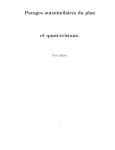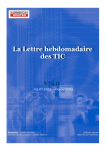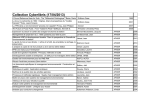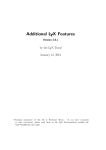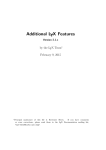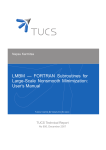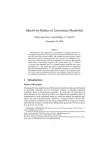Download AfM user guide for Arkiv för matematik - Mittag
Transcript
AfM user guide for Arkiv f¨
or matematik
May 30, 2013
Contents
1. Introduction
1.1. Final preparation
1.2. Changes . . . . .
1.3. Abstract . . . . .
1.4. Colour figures . .
.
.
.
.
.
.
.
.
.
.
.
.
.
.
.
.
.
.
.
.
.
.
.
.
.
.
.
.
.
.
.
.
.
.
.
.
.
.
.
.
.
.
.
.
.
.
.
.
.
.
.
.
.
.
.
.
2
2
2
2
2
2. TEXnical instructions
2.1. Additional options to \documentclass . .
2.2. Self-defined macros . . . . . . . . . . . . .
2.3. Packages . . . . . . . . . . . . . . . . . . .
2.4. Figures . . . . . . . . . . . . . . . . . . .
2.5. Tildes, hats, bars, checks, breves, and vecs
2.6. Commutative diagrams . . . . . . . . . .
2.7. Theorem-like environments . . . . . . . .
2.8. Linebreaks . . . . . . . . . . . . . . . . . .
.
.
.
.
.
.
.
.
.
.
.
.
.
.
.
.
.
.
.
.
.
.
.
.
.
.
.
.
.
.
.
.
.
.
.
.
.
.
.
.
.
.
.
.
.
.
.
.
.
.
.
.
.
.
.
.
.
.
.
.
.
.
.
.
.
.
.
.
.
.
.
.
.
.
.
.
.
.
.
.
.
.
.
.
.
.
.
.
.
.
.
.
.
.
.
.
.
.
.
.
.
.
.
.
2
3
3
3
4
4
4
4
4
. . . . . . . . . .
. . . . . . . . . .
. . . . . . . . . .
. . . . . . . . . .
. . . . . . . . . .
. . . . . . . . . .
. . . . . . . . . .
. . . . . . . . . .
. . . . . . . . . .
. . . . . . . . . .
and differentials
. . . . . . . . . .
. . . . . . . . . .
. . . . . . . . . .
. . . . . . . . . .
. . . . . . . . . .
.
.
.
.
.
.
.
.
.
.
.
.
.
.
.
.
.
.
.
.
.
.
.
.
.
.
.
.
.
.
.
.
5
5
5
5
5
6
6
6
6
6
7
7
8
8
8
8
9
.
.
.
.
.
.
.
.
.
.
.
.
.
.
.
.
.
.
.
.
.
.
.
.
.
.
.
.
.
.
.
.
.
.
.
.
.
.
.
.
.
.
.
.
.
.
.
.
.
.
.
.
3. Typographical instructions
3.0.1. Authors’ names . . . . . . . . . . . .
3.1. Language . . . . . . . . . . . . . . . . . . .
3.1.1. Spelling . . . . . . . . . . . . . . . .
3.1.2. Abbreviations . . . . . . . . . . . . .
3.1.3. Denote . . . . . . . . . . . . . . . . .
3.1.4. Italic correction (\/) . . . . . . . . .
3.2. Mathematical expressions . . . . . . . . . .
3.2.1. Parentheses . . . . . . . . . . . . . .
3.2.2. Sets . . . . . . . . . . . . . . . . . .
3.2.3. Fractions . . . . . . . . . . . . . . .
3.2.4. Integrals, sums, unions, intersections
3.2.5. Sequences and matrices . . . . . . .
3.2.6. Elementary functions . . . . . . . . .
3.2.7. Operators . . . . . . . . . . . . . . .
3.2.8. \notin (∈)
/ . . . . . . . . . . . . . .
3.2.9. \forall (∀) and \exists (∃) . . . .
1
3.2.10. \cdot ( · ) . . . .
3.2.11. Norms . . . . . .
3.2.12. Restrictions . . .
3.2.13. i and ` . . . . . .
3.2.14. Mappings . . . .
. .
3.2.15. Proofs and
3.3. References . . . . . . . .
3.3.1. Spelling of names
.
.
.
.
.
.
.
.
.
.
.
.
.
.
.
.
.
.
.
.
.
.
.
.
.
.
.
.
.
.
.
.
.
.
.
.
.
.
.
.
.
.
.
.
.
.
.
.
.
.
.
.
.
.
.
.
.
.
.
.
.
.
.
.
.
.
.
.
.
.
.
.
.
.
.
.
.
.
.
.
.
.
.
.
.
.
.
.
.
.
.
.
.
.
.
.
.
.
.
.
.
.
.
.
.
.
.
.
.
.
.
.
.
.
.
.
.
.
.
.
.
.
.
.
.
.
.
.
.
.
.
.
.
.
.
.
.
.
.
.
.
.
.
.
.
.
.
.
.
.
.
.
.
.
.
.
.
.
.
.
.
.
.
.
.
.
.
.
.
.
.
.
.
.
.
.
.
.
.
.
.
.
.
.
9
9
9
9
9
9
10
11
Section 1 was written by Institut Mittag-Leffler, Section 2 by LE-TEX, and
Section 3 by Anders Bj¨
orn.
1.
1.1.
Introduction
Final preparation
To prepare the final files of your accepted paper for Arkiv f¨
or matematik (AfM )
open the afm-template.tex file, and use it as the basis for your article. (You
will also need to have the other files of this package available.) Rename the
tex file with the surname (in small letters) of the (first) author of your paper.
Please follow the instructions given in the template file and in this user guide
as close as possible.
1.2.
Changes
N.B. Changes other than typographical must be approved by the editor in
charge.
1.3.
Abstract
Please add an abstract at the beginning of your paper. It will also be generally
available on the Springer website for Arkiv f¨
or matematik. Therefore the abstract should make sense without the rest of the paper (e.g. rather than referring
to say [3] it is desirable to write out the reference data in full).
1.4.
Colour figures
AfM standard is figures in black and white (grey scales). If you wish to have
figures printed in colour, you have to be prepared to pay for the extra printing
cost. In the online version colour figures will appear free of charge.
2.
TEXnical instructions
The AfM-SVJour document class is purpose-built for the typesetting of Arkiv
f¨
or matematik (AfM ) due to the special and careful layout rules of this journal.
2
It is a modification (and in some parts an enhancement) of Springer’s SVJour
document class.
The intention of the preparation of this special document class is to avoid
extensive changes during the typesetting process. It should also help to reduce
the number of potentially resulting errors.
This section contains some basic instructions, of TEXnical nature, to be
taken into consideration when adapting a paper to the AfM-SVJour document
class. The instructions here complement those given in the template file.
Section 3, the layout part, gives a detailed description of some of the typesetting rules for Arkiv f¨
or matematik .
2.1.
Additional options to \documentclass
The following list contains the (non-standard) options to \documentclass with
a short description.
numbook all counters are of the structure “section.counter”
numbookfigure all figure counters are of the structure “section.counter”
numbooktable all table counters are of the structure “section.counter”
envcountsect all theorem-like-environment (in short: theorem) counters are
of the structure “section.counter”
envcountsame uses one counter for all theorems
envcountreset resets the theorem counter(s) every new section
envcountsubsectreset resets the theorem counter(s) every new subsection
envcountsubsubsectreset resets the theorem counter(s) every new subsubsection.
Please also note that the option envcountsect disables the counter resets.
2.2.
Self-defined macros
Please do the typesetting without self-defined macros that use non-standard
fonts, change font sizes to non-standard values or construct terms in a non-AfM
standard way. If these macros do not fit the AfM standards they have to be
replaced by the typesetter.
2.3.
Packages
Please reduce the number of added packages to a minimum. They also have to
be replaced if they do not fit the AfM standard. If additional packages are used
please make sure that all file(s) are enclosed. The packages amsmath, amssymb
and xypic are included by default and do not need to be submitted.
3
2.4.
Figures
Figures should be submitted separately as encapsulated postscript (.eps) files.
Please use \includegraphics to embed figures.
For colour figures see also Section 1.4.
2.5.
Tildes, hats, bars, checks, breves, and vecs
Please use \tilde, \hat, \bar, \check, \breve, and \vec to typeset these
accents in mathematical expressions. Their sizes will be adjusted automatically
according to the AfM layout rules. If the size of some accents is not correctly
displayed on your system, please leave it unchanged. Due to font size differences
discrepancies are possible in exceptional cases. The accent size will be displayed
correctly at the typesetter’s.
2.6.
Commutative diagrams
Due to the AfM rules all commutative diagrams are to be typeset using the XYpic package of Kristoffer H. Rose. Commutative diagrams typeset with other
packages will have to be reprocessed.
The XY-pic package is available at
http://www.ctan.org/tex-archive/macros/generic/diagrams/xypic/
2.7.
Theorem-like environments
The following theorem-like environments are predefined:
•
•
•
•
•
•
•
•
•
• lemma
theorem
claim (*)
proof (*)
case
conjecture
corollary
definition
example
exercise
• note
• problem
• property
• proposition
• question
• solution
• remark
(*) Unnumbered.
2.8.
Linebreaks
Please do not insert linebreaks in the text parts manually. Due to minimal
differences in the font sizes the layout of your paper will not always be exactly
the same at the typesetter’s. Except for multi-line equations, all manually
inserted linebreaks will be removed. If it is necessary to avoid linebreaks to
ensure the correct meaning of a term, then the use of \hbox is recommended.
4
3.
Typographical instructions
Some of the comments below are more difficult to take care of than others. All
authors should make sure that they comply with the instructions on references
in Section 3.3. As for the other instructions, we do not expect all authors to
fully comply with all of them, but we do expect all authors to do their best
(without having to consult other sources of information).
When typesetting a paper a major concern should be to help the reader by
giving it high readability. An important part is that the notation should be
consistent. One should not, e.g., mix eiα and eαi , unless there is a clear reason
for their distinction.
Another important aspect is not to write in an atypical way (such as using
strange wording or notation), so as not to draw the reader’s attention away from
the main purpose of the text.
3.0.1.
Authors’ names
In AfM we insist on writing at least one first name in full for every author of
a paper. Initials may be given for other first names.
3.1.
Language
In AfM we publish papers in English, French and German. The comments in
this section primarily concern papers in English.
3.1.1.
Spelling
In AfM we accept both American and British spelling. The spelling should be
consistent throughout (this is a more common problem with joint papers). For
instance do not mix non-linear and nonlinear (both are acceptable).
The authors of papers in French should note that these papers do not get the
same kind of language check during the typesetting process, so these authors
have an even larger responsibility of writing a good language with correct and
consistent spelling.
For the spelling of names see Section 3.3.1.
3.1.2.
Abbreviations
Such standard abbreviations as e.g., i.e., viz., and the mathematical standard
abbreviations a.e. and a.a. may be used without explanation. On the other hand
to write, e.g., PDE, ODE or psh (for plurisubharmonic) without any explanation
is not acceptable. If such abbreviations only occur a few times they should be
replaced by their meaning, otherwise an explanation should be given, usually
on the first occurrence, e.g.
“... second order ordinary differential equations (ODEs) describe ...”.
5
When abbreviations such as i.e., e.g., viz., a.e., q.e., etc., are used one should
make sure that the final period is not an end-of-sentence period (unless it really
ends a sentence). The problem is only if the final period is followed by a space
as e.g. here, which was typeset as e.g.\ here.
3.1.3.
Denote
A common mistake in the mathematical literature is to use denote incorrectly.
It is not acceptable to write “denote X =A∪B. A correct use of denote is seen
in “let X denote the union A∪B”.
3.1.4.
Italic correction (\/)
In certain situations one has to insert italic correction (\/) manually. If one
uses \emph whenever something is emphasized in normal text, then one almost always only has to look at theorem-like structures and detect formulas
within them starting with an upright character, which necessitates an italic
correction before it, e.g. in “Let A be a subset of R.” This was typeset as
Let $A$ be a~subset of\/ $\mathbf{R}$.
Note that no italic correction needs to be inserted after “.” and “,”, and one
can also survive without inserting them on low characters such as “a” and “e”.
3.2.
Mathematical expressions
3.2.1.
Parentheses
There are many types of parentheses available (), [], {}, hi, etc. Most of these
have special meaning, e.g. when defining a set we use {} (see Section 3.2.2).
Due to the special meaning of {} in many situations, in AfM we accept only ()
and [] for usage as ordinary parentheses with no special meaning.
To increase readability in AfM we insist on avoiding unnecessary parentheses, e.g., instead of
(f (x))2 and a/(bc)
we write
f (x)2
and a/bc.
Please do not use < and > as parentheses, use \langle and \rangle instead
as in hx, yi (typeset as \langle x,y\rangle).
3.2.2.
Sets
In AfM we accept three ways of writing sets
{x∈A:1<x<2},
{x∈A;1<x<2},
{x∈A|1<x<2}.
6
The authors should choose one of these ways and use it consistently. To use
comma (,) instead is not acceptable. In the second case please use the command
\semicolon (which is defined in ml-afm.sty) and in the last case please use
\mid (but if the braces {} are larger also the | should be larger in which case
one has to use just |, together with \bigm etc.).
Please use \setminus (\) to denote the difference of sets.
Abbreviating {x:u(x)>0} by {u>0} is not acceptable (the latter is really
a set of u’s not x’s). However, if such constructions occur frequently this can
be accepted, provided that a comment on the abuse of notation is given.
In AfM we denote the standard sets either using boldface, N, Z, Q, R
and C, or blackboard bold, N, Z, Q, R and C. Of course the usage should be
consistent.
3.2.3.
Fractions
1
.
In AfM we write fractions between explicit integers in textstyle as 12 and 10
All other fractions in textstyle are written using /, so, e.g., we write 1/2d and
1
∂
∂/∂x (and not 2d
and ∂x
). A fraction like d/2 can alternatively be written as
1
d
(but
please
be
consistent).
2
In sub- and superscripts we always write fractions using /, e.g., f 1/2 . In
displaystyle, on the other hand, we encourage the use of fractions such as
p
.
q
3.2.4.
Integrals, sums, unions, intersections and differentials
In expressions like
Z
ZZ
f (x) dx
and
f (x) dx dy.
A
A
one should remember to have a thinspace (\,) before dx. In AfM the d is
set in math italic. We also insist on explicitly writing the set over which the
integration is done, if it is not too cumbersome to write. The set may be given
as a condition as in
Z
f (x) dx.
|x|<1
(An exception to the rule is if measures and their restrictions are clearly distinguished and it is clear on which set every measure is defined, then the set may
be omitted.)
Similarly thinspace (\,) should be used in differentials such as x dy+y dx.
We also insist on the limits being explicit in sums, unions, intersections etc.,
as in
∞
k
X
[
aj , and
Ej ,
j=1
j=1
7
again with the exception of too cumbersome cases.
As for unions and intersections also note thatS\cup (∪) and \cap
T (∩) are
used in expressionsTlike X ∪Y , whereas \bigcup ( ) and \bigcap ( ) are used
∞
in expressions like j=1 Ej .
3.2.5.
Sequences and matrices
In AfM we write sequences using braces, e.g., {ak }∞
k=1 . As with sums etc. above
we insist on the limits being given. When explicit limits cannot be given (or are
too cumbersome) one should at least mark the index as in {ak }k .
For matrices {ajk } or tensors we do not require indices to be shown as
subscripts.
3.2.6.
Elementary functions
We write the elementary functions as they usually appear in modern higher
mathematics, e.g. log, tan, sinh, cosh and arcsin (not ln, tg, sh, ch nor sin−1 ).
If some other logarithm is more relevant than the natural logarithm one can
either write it explicitly as log2 n, or add a sentence such as “By log we denote
the logarithm to the base 2.”
3.2.7.
Operators
Math operators are set upright in the same way as elementary functions. The
preferable way to define such operators is to use commands like
\DeclareMathOperator{\diam}{diam}
\DeclareMathOperator*{\essinf}{ess\,inf}
(These commands come from the package amsmath which is used by the
AfM-SVJour document class.)
In the latter definition we have inserted a thinspace (\,) and the ∗ means
that the limits appear as on lim, i.e. sub- and superscripts appear below and
above ess inf in displaystyle as in
ess inf u(x).
x∈B
In AfM we set function classes such as BMO(Ω) and VMO(Ω) upright. Similarly we set groups such as SO(n) and PSL(2) upright, and also abbreviations
(with at least two letters) as in L1loc (R), σac (T ) and CR-manifold. This is most
easily handled using \DeclareMathOperator or \textup.
Note also that when | is used as a relation, as in p|q, one should write it as
\mid.
3.2.8.
\notin (∈)
/
Please use \notin (∈)
/ and never \not\in (6∈). (Already Knuth observed that
the latter is inferior and that it should preferably never be used.)
8
3.2.9.
\forall (∀) and \exists (∃)
In AfM we do not accept the use of \forall (∀) and \exists (∃) with the sole
exception of articles dealing with formal logical expressions (when there is no
alternative).
3.2.10.
\cdot ( · )
If AfM we usually avoid using \cdot ( · ) for ordinary multiplication between
complex numbers. An exception is of course in expressions like 2·3. In expressions like |x| |y| we prefer to insert a thinspace (\,) instead of \cdot ( · ).
3.2.11.
Norms
Please use \| (k) and not || (||) when writing norms such as kxk.
3.2.12.
Restrictions
In AfM we write the restriction of f to the set A as f |A .
3.2.13.
i and `
Authors who use i for the imaginary unit somewhere in their paper should avoid
also using i as an index. (In AfM we do want to set the imaginary unit as i
(not as, e.g., i or ι).) If necessary please change your indices (one possibility is
to permute i7→ j 7→ k7→ l).
In AfM we accept the use of `. However it should not be used as an index
or as a summation variable, so in
n
X
(2l+1)
and al ,
l=1
one should use the usual l.
3.2.14.
Mappings
For mappings such as x7→ x2 one should use →
7 (\mapsto) and not →.
In mappings such as f : A→B (f\colon A \to B), please use \colon.
3.2.15.
Proofs and
Proofs can be set in several ways, but the preferable way is to use the proof
environment. Most proofs start with “Proof.” or, e.g., “Proof of Theorem 1.1.”,
and then we insist on ending it by a . The should not be used for anything
else but ending such proofs.
If a proof follows soon after the statement of a theorem (or similar) the proof
should start with “Proof.”.
For a proof making up a whole (sub)section with a title such as “Proof of
Theorem 1.1”, no should be used.
9
3.3.
References
Please refer to references using \cite. Only cite one reference in each citation,
i.e. write “[L] and [M]” instead of “[L,M]”. All references in the reference list
should be cited in the text (please delete unnecessary references).
Authors should make sure that the information in the reference list is complete. Mathematical Reviews (Math. Rev., the web version is called MathSciNet)
and Zentralblatt f¨
ur Mathematik contain the necessary information.
The references should either be numbered, or should have alphanumerical
labels (which should be kept short!). They should be sorted alphachronologically
(regardless of their labels), i.e., first according to the first author, then the
second author, etc. For several items by the same authors the year of publication
should decide the sorting.
Here are a few examples.
¨ rn, J., Wiener criterion for Cheeger p-harmonic functions on metric
[B] Bjo
spaces, in Potential Theory in Matsue, Advanced Studies in Pure Mathematics 44, pp. 103–115, Mathematical Society of Japan, Tokyo, 2006
[HK] Heinonen, J. and Koskela, P., Quasiconformal maps in metric spaces
with controlled geometry, Acta Math. 181 (1998), 1–61.
[KZ] Keith, S. and Zhong, X., The Poincar´e inequality is an open ended
condition, Preprint, Jyv¨askyl¨a, 2003.
[KM] Kinnunen, J. and Martio, O., Choquet property for the Sobolev capacity in metric spaces, in Proceedings on Analysis and Geometry (Novosibirsk, Akademgorodok, 1999 ), pp. 285–290, Sobolev Institute Press, Novosibirsk, 2000.
[L] Landkof, N. S., Foundations of Modern Potential Theory, Nauka, Moscow, 1966 (Russian). English transl.: Springer, Berlin–Heidelberg, 1972.
[Le] Lenells, J., Riemannian geometry on the diffeomorphism group of the
circle, to appear in Ark. Mat.
[M] Maz0 ya, V. G., On the continuity at a boundary point of solutions of
quasi-linear elliptic equations, Vestnik Leningrad. Univ. Mat. Mekh.
Astronom. 25:13 (1970), 42–55 (Russian). English transl.: Vestnik Leningrad Univ. Math. 3 (1976), 225–242.
[R] Rudin, W., Functional Analysis, 2nd ed., McGraw-Hill, New York, 1991.
[W] Wermer, J., Potential Theory, Lecture Notes in Math. 408, Springer,
Berlin–Heidelberg, 1974.
Note the following:
Journal papers: The name of the journal should be abbreviated using the
current abbreviation by Math. Rev.
Book series: The name of a book series (and volume number) is optional,
apart from in the case of Lecture Notes in Math. by Springer. (This applies
to books, proceedings and other collective publications.)
10
Translations: For a paper/book not written in a language using the Latin
alphabet, e.g. Russian, Chinese or Japanese, the title should be translated
into English, with the original language stated within brackets. If an
English translation exists both a reference to it and to the original should
be made. (See [L] and [M].)
Please consult one of the latest issues of Arkiv f¨
or matematik for more examples of references.
3.3.1.
Spelling of names
The name of a person should be spelt consistently throughout the paper. In case
of transcription from Cyrillic it should follow the present transcription system
of Math. Rev. or should be the form that the person herself/himself uses when
writing in English today.
Here are the spellings of some names of mathematicians (one do not necessarily have to use all initials):
Blocki, Z.
Ces`
aro, E.
Erd˝
os, P.
Foia¸s, C.
Fornæss, J. E.
Forstneriˇc, F.
Hajlasz, P.
Havin, V. P.
Hele-Shaw, H. S.
Henkin, G. M.
H¨older, O.
K¨ahler, E.
Kre˘ın, S. G.
Maz0 ya, V. G.
M¨obius, A. F.
Nikol0 skii, S. M.
R´enyi, A.
Sierpi´
nski, W.
Solomyak, M.
Stensønes, B.
Szeg˝o, G.
Sz.-Nagy, B.
Uraltseva, N. N
Please observe the use of \H in Erd˝os and Szeg˝o. Note also that we use
\cprime (which is defined in ml-afm.sty) to denote the Cyrillic soft character
0
in Maz0 ya and Nikol0 skii.
11











